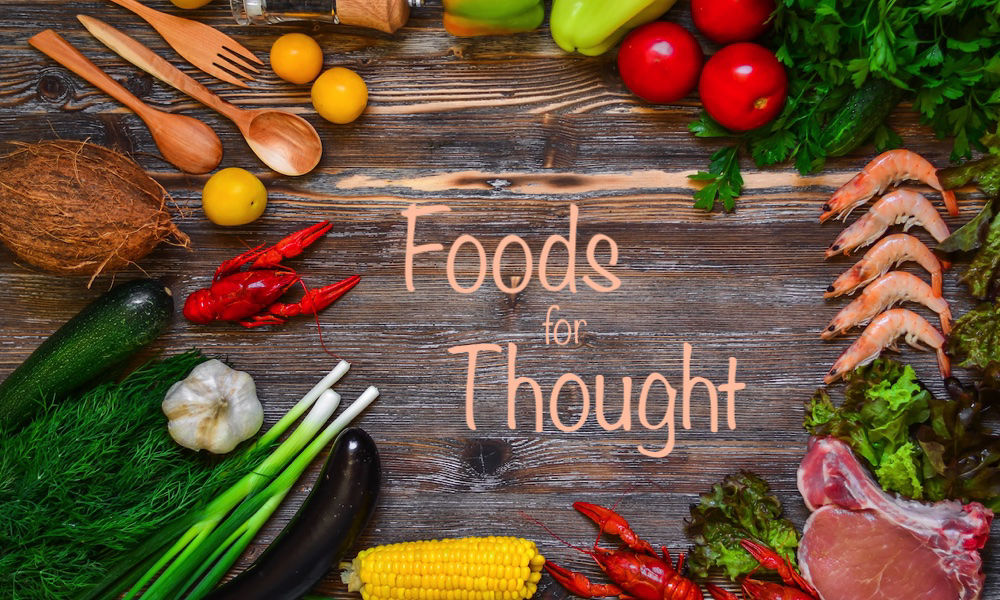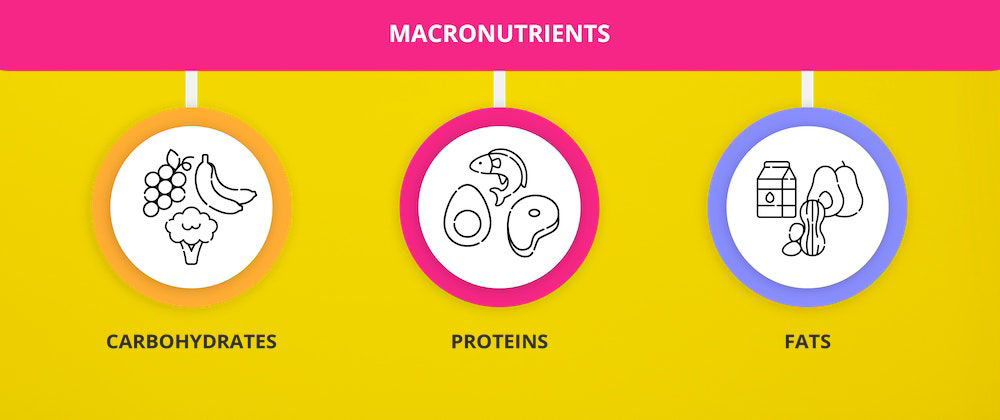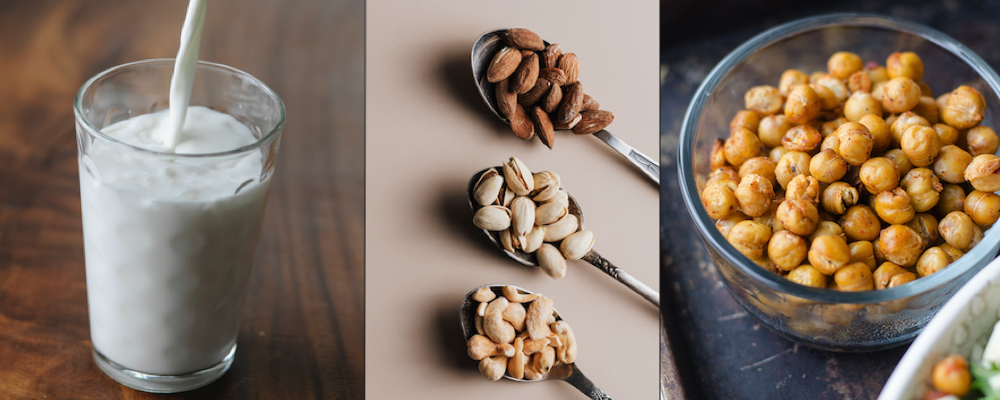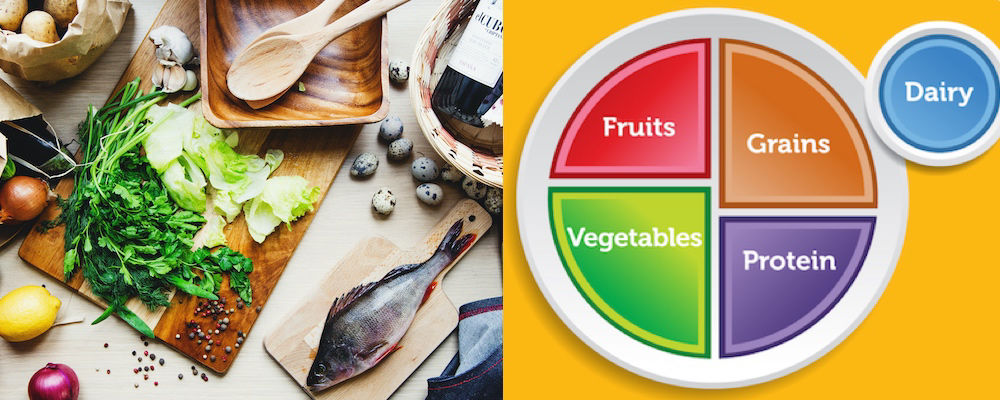
March is National Nutrition Month©, a time when we can start our eating habits with a clean slate by putting informed food choices on a new plate. Beginning as a presidential proclamation for a week-long observance back in March 1973, the Academy of Nutrition and Dietetics’ annual nutrition education campaign expanded into a month-long event in 1980, due to its popularity and the public’s increasing interest in good nutrition.
Every year, the Academy focuses on a particular theme surrounding nutrition, and 2021 is no exception with “Personalize Your Plate.” The theme promotes producing nutritious meals that meet one’s cultural and personal food preferences. A variety of educational handouts and materials are available through eatrightpro.org.
Of course, good nutrition is something to be appreciated and mindful of all year round. That's why we're offering several features, including this one, that serve up some edible enlightenment on the food groups that fill your plate. Before we to help whet your appetite for nutritional knowledge, though, it’s okay to take our guidance with a pinch of salt. We realize that everyone, and every body, is different. There’s no one-diet-fits-all solution. Some may follow a daily caloric intake that differs from the standard recommendations of 2,500 calories a day for men, 2,000 calories a day for women. Others may have health conditions that prohibit them from eating specific foods or certain portions of foods. Age can also be a factor, as your metabolism slows and can’t break down the food you chow down as easily as it used to.
Simply stated, we’re presenting guidance off a daily 2,500-calorie intake with the intent to educate and inform. You know you better than anyone else, so you can best determine how much of our informational menu to digest. And with that, bon appetit.
DIVIDE BEFORE CONQUERING
First things first: The US Department of Agriculture’s (USDA) MyPlate guidelines recommend that you split your plate into four quarters, with each quarter represented by a specific food group. By that, we mean proteins, fruits, vegetables and grains. Depending on your specific dietary needs, health, age or physical activity, you may want to allocate a little more of one, a little less of another. All good; the main thing is that you’re planning how you should fill your plate, which is a key ingredient toward healthful eating.
Wait, isn't dairy a food group, too? Yes, it is, and a very important one that delivers protein and calcium. You can certainly place some cheese on your plate (cottage cheese is among the healthier choices) or have a cup of yogurt on the side. Add some low-fat milk to drink about 30 minutes before or after your meal, to help with digestion.
For the moment, though, let’s order from the four-quarters plate. Each week we’ll take a look at the health benefits offered by each food group. and make some recommendations as to the best types of food to enjoy within each collection.

THE POWER OF PROTEIN
Of the three macronutrients in our body, we’re most partial to protein over fats and carbs. In fact, we’d recommend eating that portion of your plate first. A study conducted by researchers from Weill Cornell Medical College[1] found that glucose and insulin levels significantly lower when following an eating sequence of protein first, followed by vegetables and fruit, then grains. (That sequence is especially important for those diagnosed with type 2 diabetes.)
You’ll find protein just about everywhere in your body – bone, muscle, hair, nails, skin, you name it – because it’s made up of 20 different amino acids. Some amino acids are made from scratch, some are modified from others, and nine in particular come from what we eat.
According to the current Recommended Dietary Allowance (RDA), adults’ daily minimum intake of protein should consist of 0.8 grams for every 2.2 pounds of body weight. Eating an average of 6½ ounces of lean protein foods in a daily 2,500 calorie diet takes you pretty close to hitting that RDA, and it can offer a ton of health benefits. Studies show that it helps you not only build strength and muscle,[2] but also maintain bone mass[3] even as you age or while you try to lose weight.
When it comes to battling the scales, protein also provides your metabolism with a much-needed lift and aids in burning off those not-so-much-needed calories. Research shows how it keeps ghrelin, aka your hunger hormone,[4] in check while producing other hormones to help you feel full faster. Depending on your intake, protein also contributes to lowering your blood pressure[5] as well as your risk of cardiovascular disease.

THE LEAN AND MEAN ON PROTEIN
In short, protein is a powerhouse. So, what kinds of protein should you eat to power your house?
You can’t go wrong with lean beef, pork, veal and lamb. Besides offering plenty of protein, they’re Vitamin B- and D-rich, and packed with zinc, iron, magnesium, niacin, phosphorous, potassium and selenium thiamine. They also contain leucine,[6] an amino acid that’s crucial for building, repairing and maintaining muscle and bone tissue.
The American Heart Association (AMA) recommends two to three servings of fish or seafood a week. Most cold-water fatty fish – including salmon, tuna, mackerel, sardines, trout, anchovies and herring – promote both brain and heart health because they’re mineral-stacked and loaded with Omega-3s, polyunsaturated fatty acids that our bodies can’t naturally produce. Two of those Omega-3s – eicosapentaenoic acid (EPA) and docosahexaenoic acid (DHA) – are great for boosting and maintaining your cardiovascular health,[7] and research indicates they can be effective in treating mood disorders.[8]
Remember that age-old question “Which came first: The chicken or the egg?” Well, we’re 100 percent pro-egg for breakfast – it’s a “total package” protein that supplies every B vitamin, phosphorus, calcium, amino acids and heart-healthy unsaturated fats. Come lunch or dinner, though, we put our collective feed bag on for the likes of skinless chicken, turkey or duck. These most palatable of poultries, while high on protein, vitamins and minerals, edge out red meat because they’re leaner and considerably lower in saturated fat. If you want to keep running lean and mean, white poultry meat is a great way to keep the pounds off.[9]

Of course, meat and fish may not be your thing. Thankfully, there are other protein options, including the food group you thought we forgot about. Taking in 3 cups of dairy every day can promote bone health[10] and reduce muscle loss[11] as you grow older. We recommend dairy choices like cheese, yogurt (especially the Greek variety) and low-fat milk, all of which are great sources for complete protein as well as calcium, phosphorus, and Vitamins A, B2 and B12, and D.
You can also find potent protein production in nuts, most of which are the seeds of certain fruits. Nuts like almonds, walnuts and pistachios deliver both high-quality protein and fiber. Brazil nuts provide nearly 10 times the Recommended Dietary Allowance’s (RDA) Daily Value for selenium. Selenium is an antioxidant that boosts the metabolism of thyroid hormones[12] while fighting off cell and tissue damage as well as decreasing oxidative stress[13] in your body.
Another sound alternative are legumes, which include beans, peas and lentils. True, they fall under the vegetable category, but they’re plant-based proteins that are lean in total fat while dense in fiber, folate, iron, potassium, phosphorus, zinc and B vitamins. Edamame (or soybeans), chickpeas, lentils, kidney, black, pinto and navy are great go-to beans, all of which can not only help lower total and LDL cholesterol levels,[14] but also conceivably cover half of that ideal plate mix you’re striving to achieve.
For more "Foods for thought," check out: Part 2: Fruits and Vegetables | Part 3: Grains
FOLLOW US ON FACEBOOK, INSTAGRAM, TWITTER AND YOUTUBE
References:
[1]Shukla AP, Iliescu RG, Thomas CE, Aronne LJ. Food order has a significant impact on postprandial glucose and insulin levels. Diabetes Care 2015;38:e98–e99
[2]Bosse JD, Dixon BM. Dietary protein to maximize resistance training: a review and examination of protein spread and change theories. J Int Soc Sports Nutr. 2012 Sep 8;9(1):42. doi: 10.1186/1550-2783-9-42. PMID: 22958314; PMCID: PMC3518828.
[3]Kerstetter JE, Kenny AM, Insogna KL. Dietary protein and skeletal health: a review of recent human research. Curr Opin Lipidol. 2011 Feb;22(1):16-20. doi: 10.1097/MOL.0b013e3283419441. PMID: 21102327; PMCID: PMC4659357.
[4]Karen E. Foster-Schubert, Joost Overduin, Catherine E. Prudom, Jianhua Liu, Holly S. Callahan, Bruce D. Gaylinn, Michael O. Thorner, David E. Cummings, Acyl and Total Ghrelin Are Suppressed Strongly by Ingested Proteins, Weakly by Lipids, and Biphasically by Carbohydrates, The Journal of Clinical Endocrinology & Metabolism, Volume 93, Issue 5, 1 May 2008, Pages 1971–1979, https://doi.org/10.1210/jc.2007-2289
[5]Justin R. Buendia, M. Loring Bradlee, Martha R. Singer, Lynn L. Moore, Diets Higher in Protein Predict Lower High Blood Pressure Risk in Framingham Offspring Study Adults, American Journal of Hypertension, Volume 28, Issue 3, March 2015, Pages 372–379, https://doi.org/10.1093/ajh/hpu157
[6]Pedroso JA, Zampieri TT, Donato J Jr. Reviewing the Effects of L-Leucine Supplementation in the Regulation of Food Intake, Energy Balance, and Glucose Homeostasis. Nutrients. 2015 May 22;7(5):3914-37. doi: 10.3390/nu7053914. PMID: 26007339; PMCID: PMC4446786.
[7]Schwalfenberg G. Omega-3 fatty acids: their beneficial role in cardiovascular health. Can Fam Physician. 2006 Jun;52(6):734-40. Erratum in: Can Fam Physician. 2006 Aug;52:952. PMID: 16812965; PMCID: PMC1780156.
[8]Liao Y, Xie B, Zhang H, He Q, Guo L, Subramaniapillai M, Fan B, Lu C, Mclntyer RS. Efficacy of omega-3 PUFAs in depression: A meta-analysis. Transl Psychiatry. 2019 Aug 5;9(1):190. doi: 10.1038/s41398-019-0515-5. PMID: 31383846; PMCID: PMC6683166.
[9]Marangoni F, Corsello G, Cricelli C, Ferrara N, Ghiselli A, Lucchin L, Poli A. Role of poultry meat in a balanced diet aimed at maintaining health and wellbeing: an Italian consensus document. Food Nutr Res. 2015 Jun 9;59:27606. doi: 10.3402/fnr.v59.27606. PMID: 26065493; PMCID: PMC4462824.
[10]Iuliano S, Hill TR. Dairy foods and bone health throughout the lifespan: a critical appraisal of the evidence. Br J Nutr. 2019 Apr;121(7):763-772. doi: 10.1017/S0007114518003859. Epub 2019 Jan 14. PMID: 30638442; PMCID: PMC6521786.
[11]Du Y, Oh C, No J. Advantage of Dairy for Improving Aging Muscle. J Obes Metab Syndr. 2019 Sep;28(3):167-174. doi: 10.7570/jomes.2019.28.3.167. Epub 2019 Mar 30. PMID: 31583381; PMCID: PMC6774446.
[12]Ventura M, Melo M, Carrilho F. Selenium and Thyroid Disease: From Pathophysiology to Treatment. Int J Endocrinol. 2017;2017:1297658. doi: 10.1155/2017/1297658. Epub 2017 Jan 31. PMID: 28255299; PMCID: PMC5307254.
[13]Tinggi U. Selenium: its role as antioxidant in human health. Environ Health Prev Med. 2008 Mar;13(2):102-8. doi: 10.1007/s12199-007-0019-4. Epub 2008 Feb 28. PMID: 19568888; PMCID: PMC2698273.
[14]Polak R, Phillips EM, Campbell A. Legumes: Health Benefits and Culinary Approaches to Increase Intake. Clin Diabetes. 2015 Oct;33(4):198-205. doi: 10.2337/diaclin.33.4.198. PMID: 26487796; PMCID: PMC4608274.
Related:
• The hard(?) truth about erectile dysfunction, your sex drive and TRT
• WATCH: How to make sense of your injection dosages
• Peak: Who we are, and why we're serious about your health
• 10 things to know when consulting with your hormone doctor

